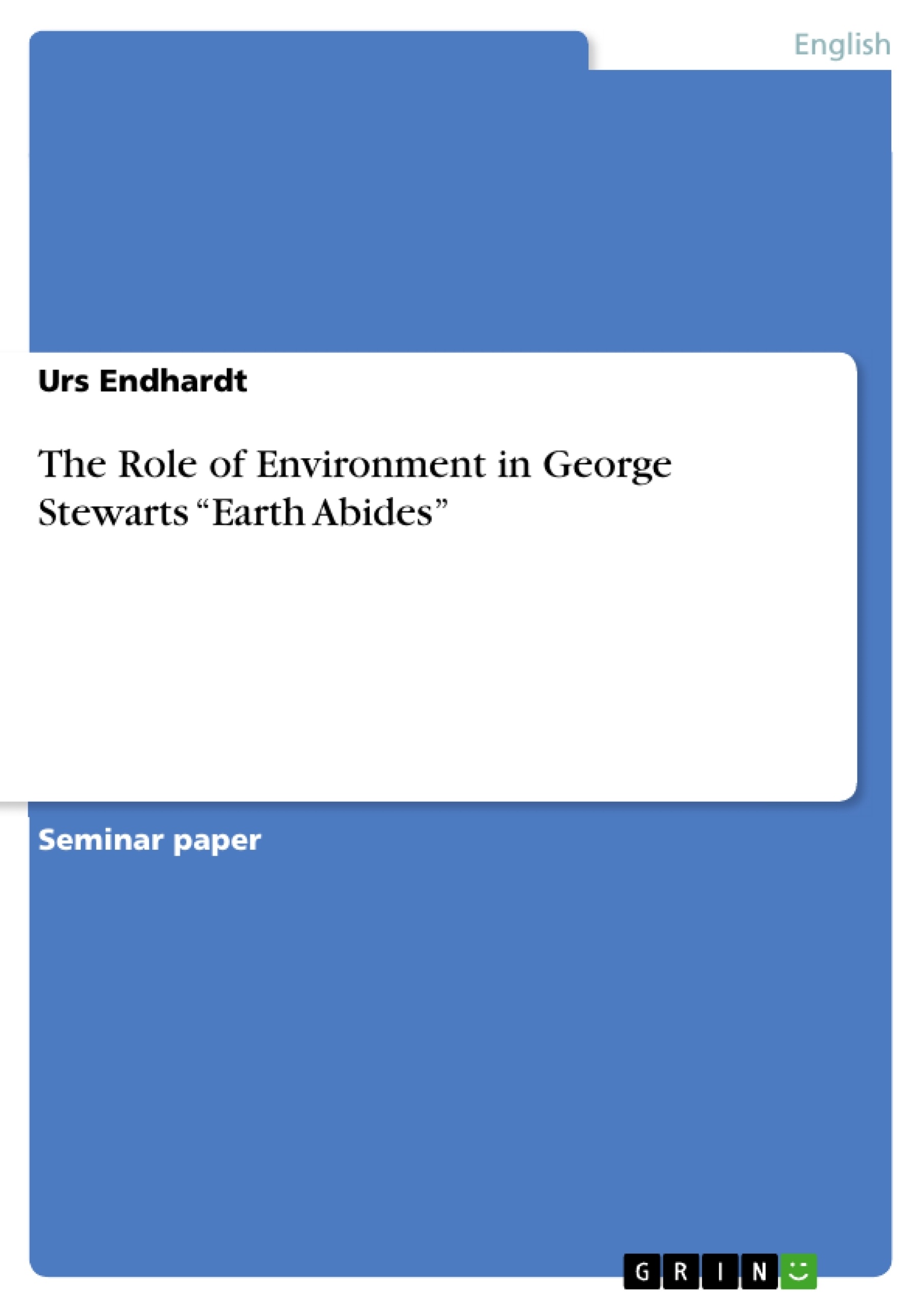The theme of nature and ecology is occurring throughout the whole novel.
This is why I would like to examine the role of natural environment and surroundings in George Stewart’s novel Earth Abides. Also I would like to find out which part ecology plays and in which way it influences the characters.
For this examination I found an appropriate book by Fred Waage which deals exactly with the terms I would like to investigate
Table of Contents
- Introduction
- Main part
Objectives and Key Themes
This paper examines the role of the natural environment and ecology in George Stewart's novel, Earth Abides. It explores how the environment influences the characters and the overall narrative. The analysis draws upon Fred Waage's work on George Stewart's ecological themes.
- The irresistible power of reverting nature and the failure of science.
- The impact of ecological changes on human survival and societal structures.
- The interplay between human actions and natural consequences.
- The shifting relationship between humanity and the environment, from dominance to adaptation.
- The cyclical nature of life and the resilience of both nature and humanity.
Chapter Summaries
Introduction: This introductory section lays out the paper's objective: to analyze the significance of the natural environment and ecology within George Stewart's Earth Abides. The author intends to investigate the influence of the ecological context on the characters' experiences and actions throughout the novel. The introduction highlights the importance of understanding the ecological dimensions of the narrative, foreshadowing a deeper exploration of the theme's impact on the story's development.
Main part: This section delves into the core themes of the novel, categorizing Earth Abides as "eco-fiction." It emphasizes the overwhelming power of nature's resurgence after a catastrophic event, contrasting the initial utopian vision of a nature-reclaimed world with the harsh realities faced by the surviving human population. The section details the challenges posed by increased populations of animals like rats and the difficulties in securing resources like water. The narrative highlights the resilience of the human species, showcasing the development of a new social structure based on cooperation and adaptation to the changed environment. The re-emergence of human society is presented as a biological process, driven by cooperative needs and ecological circumstances. The chapter further illustrates the drastic alteration of nature, particularly the demise of domesticated crops like wheat and corn, reflecting the profound impact of human extinction on the ecosystem and demonstrating the interconnectedness of human and natural systems. The section culminates in exploring the devastating consequences of a disease outbreak, emphasizing the human vulnerability and dependence on established resources, societal infrastructure, and medical technologies. The chapter emphasizes how humans move from masters of their environment to beings deeply intertwined with and dependent on its unpredictable rhythms.
Keywords
Eco-fiction, environmentalism, post-apocalyptic literature, human-nature relationship, ecological consequences, societal adaptation, resilience, survival, nature's power, human impact on environment.
Frequently Asked Questions: Earth Abides - An Ecological Analysis
What is the main focus of this paper?
This paper analyzes the role of the natural environment and ecology in George Stewart's novel, Earth Abides. It explores how the environment influences the characters and the overall narrative, drawing upon Fred Waage's work on Stewart's ecological themes.
What are the key themes explored in the analysis of Earth Abides?
The analysis explores several key themes, including the irresistible power of reverting nature and the failure of science; the impact of ecological changes on human survival and societal structures; the interplay between human actions and natural consequences; the shifting relationship between humanity and the environment, from dominance to adaptation; and the cyclical nature of life and the resilience of both nature and humanity.
What does the introduction of the paper cover?
The introduction outlines the paper's objective: to analyze the significance of the natural environment and ecology in George Stewart's Earth Abides and investigate the influence of the ecological context on the characters' experiences and actions.
What are the main points discussed in the main part of the paper?
The main part delves into the core themes, categorizing Earth Abides as "eco-fiction." It emphasizes nature's overwhelming power after a catastrophe, contrasting the initial utopian vision of a nature-reclaimed world with the harsh realities faced by survivors. It details challenges like increased animal populations and resource scarcity, highlighting human resilience and the development of a new social structure. The chapter illustrates the drastic alteration of nature and the interconnectedness of human and natural systems, culminating in exploring the devastating consequences of a disease outbreak and the shift from human dominance to dependence on the environment.
What are the key words associated with this analysis of Earth Abides?
Key words include: Eco-fiction, environmentalism, post-apocalyptic literature, human-nature relationship, ecological consequences, societal adaptation, resilience, survival, nature's power, and human impact on the environment.
What is the overall structure of the provided text?
The text provides a comprehensive language preview including a table of contents, objectives and key themes, chapter summaries, and keywords. It acts as a detailed overview of a longer academic paper.
What type of literature is Earth Abides categorized as?
The paper categorizes Earth Abides as "eco-fiction."
What is the significance of Fred Waage's work in this analysis?
The analysis draws upon Fred Waage's work on George Stewart's ecological themes to support its interpretations.
- Quote paper
- Urs Endhardt (Author), 2008, The Role of Environment in George Stewarts “Earth Abides” , Munich, GRIN Verlag, https://www.grin.com/document/130259



